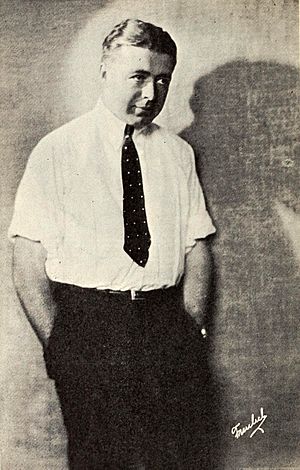Clarence Brown facts for kids
Quick facts for kids
Clarence Brown
|
|
|---|---|

Brown in 1922
|
|
| Born |
Clarence Leon Brown
May 10, 1890 Clinton, Massachusetts, U.S.
|
| Died | August 17, 1987 (aged 97) Santa Monica, California, U.S.
|
| Education | Knoxville High School University of Tennessee |
| Years active | 1915–1953 |
| Spouse(s) |
Paula Herndon Pratt
(m. 1913; div. 1920)Ona Wilson
(m. 1922; div. 1927)Marian Spies
(m. 1946) |
| Children | 1 |
Clarence Leon Brown (May 10, 1890 – August 17, 1987) was an American film director. He was known for directing many popular movies, especially those starring famous actresses like Greta Garbo and Joan Crawford. He was nominated for several Academy Awards for his directing work.
Contents
Early Life and First Interests
Clarence Brown was born in Clinton, Massachusetts. When he was 11, his family moved to Tennessee. He attended Knoxville High School and then the University of Tennessee. He graduated from college at age 19 with two degrees in engineering.
At first, Clarence was very interested in automobiles. He worked for a car company and even started his own car dealership in Alabama. But around 1913, he became fascinated by motion pictures. He then got a job at Peerless Studio in Fort Lee, New Jersey. There, he became an assistant to a French director named Maurice Tourneur.
Filmmaking Career
During World War I, Clarence Brown served as a fighter pilot and flight instructor. After the war, he received his first co-directing credit in 1920 for a film called The Great Redeemer. Later that year, he directed a large part of The Last of the Mohicans. This happened after his co-director, Maurice Tourneur, was injured.
In 1924, Brown moved to Universal. Soon after, he joined Metro-Goldwyn-Mayer (MGM), a very famous film studio. He stayed at MGM until the mid-1950s. At MGM, he became one of the main directors for their biggest female stars. He directed Joan Crawford six times and Greta Garbo seven times.
Clarence Brown was nominated six times for an Academy Award as a director. However, he never won the Best Director Oscar. He did win Best Foreign Film for Anna Karenina at the 1935 Venice International Film Festival. This movie starred Greta Garbo.
Overall, films directed by Brown received a total of 38 Academy Award nominations. They also won nine Oscars. In 1949, Brown won the British Academy Award for his film Intruder in the Dust.
In 1957, Clarence Brown received The George Eastman Award. This award honors people who have made important contributions to the art of film. Brown became a very wealthy man from smart real estate investments. He chose not to watch new movies after he retired. He worried that seeing them might make him want to start directing again.
The Clarence Brown Theater at the University of Tennessee is named in his honor. He holds the record for the most nominations for the Academy Award for Best Director without winning. He was nominated six times.
Personal Life
Clarence Brown was married four times during his life. His first marriage was to Paula Herndon Pratt in 1913. They divorced in 1920 and had one daughter, Adrienne Brown.
His second marriage was to Ona Wilson. This marriage lasted from 1922 until their divorce in 1927.
He later married his third wife, Alice Joyce, in 1933. They divorced in 1945.
His last marriage was to Marian Spies in 1946. They remained married until his death in 1987.
Later Years and Legacy
Clarence Brown passed away in Santa Monica, California, on August 17, 1987. He was 97 years old. He is buried at Forest Lawn Memorial Park in Glendale, California.
On February 8, 1960, Clarence Brown received a star on the Hollywood Walk of Fame. His star is located at 1752 Vine Street. It honors his important contributions to the motion picture industry.
Selected Filmography

Director
- Trilby (1915)
- The Law of the Land (1917)
- The Blue Bird (1918)
- The Great Redeemer (1920)
- The Last of the Mohicans (1920)
- The Foolish Matrons (1921)
- The Light in the Dark (1922)
- Don't Marry for Money (1923)
- The Acquittal (1923)
- The Signal Tower (1924)
- Butterfly (1924)
- The Eagle (1925)
- The Goose Woman (1925)
- Smouldering Fires (1925)
- Flesh and the Devil (1926)
- Kiki (1926)
- A Woman of Affairs (1928)
- The Trail of '98 (1929)
- Navy Blues (1929)
- Wonder of Women (1929)
- Anna Christie (1930) – Academy Award nomination for Best Director
- Romance (1930) – Academy Award nomination for Best Director
- Inspiration (1931)
- Possessed (1931)
- A Free Soul (1931) – Academy Award nomination for Best Director
- Emma (1932)
- Letty Lynton (1932)
- The Son-Daughter (1932)
- Looking forward (1933)
- Night Flight (1933)
- Sadie McKee (1934)
- Chained (1934)
- Ah, Wilderness! (1935)
- Anna Karenina (1935)
- Wife vs. Secretary (1936)
- Conquest (1937)
- Of Human Hearts (1938)
- The Rains Came (1939)
- Edison, the Man (1940)
- Come Live with Me (1941)
- They Met in Bombay (1941)
- The Human Comedy (1943) – Academy Award nominations for Best Director and for Best Picture
- The White Cliffs of Dover (1944)
- National Velvet (1944) – Academy Award nomination for Best Director
- The Yearling (1946) – Academy Award nomination for Best Director
- Song of Love (1947)
- Intruder in the Dust (1949)
- To Please a Lady (1950)
- Angels in the Outfield (1951)
- When in Rome (1952)
- Plymouth Adventure (1952)
See also
 In Spanish: Clarence Brown para niños
In Spanish: Clarence Brown para niños


